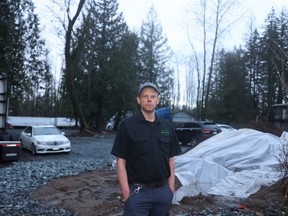Big changes in the area of Highway 1 and 176th Street in Surrey aren’t embraced by all.

Article content
Surrey’s Anniedale-Tynehead neighbourhood is set to undergo massive changes that could eventually see 30,000 people living in the area where Highway 1 meets several key regional transportation routes.
While the development will create thousands of new homes adjacent to Tynehead Regional Park, as well as new industrial and retail areas, some existing residents feel like they’re being pushed out.
Advertisement 2
Article content
Article content
“This is a pretty close-knit community — or, it used to be a close-knit community,” said Chris Marino, who has lived in the area since he was a boy. “Neighbours give each other Christmas gifts and watch each other’s houses when they’re away. But one-by-one, houses are being knocked off.”
In late November, Surrey city council endorsed a land use plan for a multi-family housing development on more than 150 acres near 96th Avenue after a school site was agreed upon with the school district. Work to bring water and sewer services to the area is underway, with construction of the first homes possible in a year or two.
When Surrey first drew up the neighbourhood concept plan for Anniedale-Tynehead in 2012, the area was slated for a “big box commercial area,” said Don Luymes, general manager of planning and development for the City of Surrey.
As the big box concept fell out of favour, much of the land was purchased by developers, who initiated an amendment to create a residential development.
“City staff supported that because, from our perspective, it made a lot more sense,” said Luymes. “It’s right up against a major park, south-facing, sloping land, great views, close to the freeway.”
Article content
Advertisement 3
Article content


Through a city-led planning process, the new development at the former big box area could see upward of 6,000 more people living there over the next two decades. The entire Anniedale-Tynehead neighbourhood could eventually house up to 30,000 people.
“We expect it to be a very popular place to live,” said Luymes.
But other parts of the neighbourhood are becoming less desirable to live. City plans have designated the areas closest to Hwy. 1, east of 176th Street and north of Golden Ears Way, for light industrial use. The area is at the centre of several important regional transportation routes, with access to the port along the South Fraser Perimeter Road, the U.S. border along Hwy. 15 and Surrey City Centre along 96th Avenue.

Marino is currently renting a home on 97th Avenue, which backs onto the former site of the historic Anniedale school. In 2022, the city approved an application for temporary use of the property for truck parking and outdoor storage.
“It’s been horrible,” he said. “There’s a fence with black mesh. Our backyards look like a prison.
While he hasn’t noticed trucks parked on the site, Marino’s backyard floods in the winter after the transport company that owns the site added gravel fill, while the bright lights surrounding the property are blinding. Complaints to the city have “fallen on deaf ears,” he said.
Advertisement 4
Article content
“It’s inevitable that this neighbourhood will become an industrial area,” said Marino. “I expect to come home from work one day and see a development sign on the house.”
But, in the meantime, he wants to live in the area where he grew up and has fond memories of small acreages, horse farms and a popular corner store.
“Residential and industrial use are like oil and water,” he said.
Luymes said to some extent that he agrees with that assessment.
The transition from residential to industrial can be “ragged,” he said, pointing to similar scenarios across the region, such as Campbell Heights in Surrey, Gloucester in Langley and the area around the Abbotsford Airport, where residential neighbourhoods have been slowly swallowed by industrial development.
“Land owners are on different time frames,” he said. “They may or may not be willing or ready to sell their property, but their neighbours have (sold) … It would be lovely if one developer had the ability to purchase all the land in one shot, but that is not the case. So there’s a period of time where these kinds of interface issues are real.”
Advertisement 5
Article content
While Surrey has designated Marino’s neighbourhood for light industrial use, there is limited servicing for the area, including sewer and water line extensions, meaning “final form development” isn’t yet possible.
In the interim, the city has been approving three-year temporary use permits for truck parking to help address the region-wide shortage of truck parking.
Luymes said the city will work with the company that owns the area behind Marino’s home to try to redirect or deflect some of the light, although there is little that can be done about ambient light in the neighbourhood.


When reached by phone Wednesday, a manager with Seven Horses Transport, the company that received the approval for truck parking at the former Anniedale school site, declined an interview.
Preet Heer, director of community planning for the City of Surrey, said the city will take another look at the Anniedale-Tynehead neighbourhood plan as part of the second stage of the planning process, with some possible “tweaks” to green spaces and riparian areas to fit with the city’s new biodiversity strategy. Green spaces can provide a buffer between homes and other types of zoning.
Advertisement 6
Article content
The city also plans to work with TransLink to ensure the development is linked to the transit system, including the new SkyTrain line that will run along the Fraser Highway corridor, which could be accessible by bus along Hwy. 15 or Surrey City Centre along 96th Avenue.

Dimple Gill, a realtor with Oakwyn Realty, called the residential development planned near Tynehead Regional Park “very exciting.” The land is owned by several developers and will include various types of housing, including some high-density areas, he said.
“This area is not developed yet and not many people know about it,” he said. “Housing is not affordable for many people, so this is an opportunity to create more homes.”
(Don Luymes is a relative of the writer of this story.)
Recommended from Editorial
-

Surrey looking to turn four city-owned sites into parking lots for big trucks
-

Why all eyes are on the coming SkyTrain extension from Surrey to Langley
-

Surrey schools a cautionary construction tale as B.C. communities bursting at the seams
gluymes@postmedia.com
Bookmark our website and support our journalism: Don’t miss the news you need to know — add VancouverSun.com and TheProvince.com to your bookmarks and sign up for our newsletters here.
You can also support our journalism by becoming a digital subscriber: For just $14 a month, you can get unlimited access to The Vancouver Sun, The Province, National Post and 13 other Canadian news sites. Support us by subscribing today: The Vancouver Sun | The Province.
Article content




















Discussion about this post